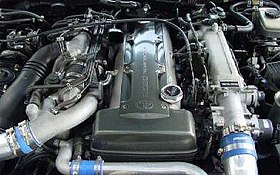Toyota JZ engine
| Toyota JZ engine | |
|---|---|
 |
|
| Overview | |
| Manufacturer | Toyota Motor Corporation |
| Production | 1990–2005 |
| Combustion chamber | |
| Configuration | inline-6 |
| Chronology | |
| Predecessor | Toyota M engine |
The Toyota JZ engine family is a series of inline-6 automobile engines. A replacement for the M-series inline-6 engines, the JZ engines were 24-valve DOHC engines. The JZ engine was offered in 2.5- and 3.0-litre versions.
The 2492 cc 1JZ version was produced from 1990 to 2007 (last sold in the Mark II BLIT Wagon and Crown Athlete). Cylinder bore was 86 mm (3.39 in) and stroke was 71.5 mm (2.81 in).
It was a 24-valve DOHC engine with two belt-driven camshafts.
Output for the early non-turbo (1990–1995) 1JZ-GE was 170 PS (125 kW; 168 bhp) at 6000 rpm and 235 N·m (173 lb·ft) at 4800 rpm.
Later released non-turbo (1995->) 1JZ-GE had output of 200 PS (147 kW; 197 bhp) at 6000 rpm and 251 N·m (185 lb·ft) at 4000 rpm.
The 2.5-litre 1JZ uses oversquare bore dimensions (86 x 71.5mm) and, in naturally aspirated guise, a 10:1 compression ratio.
With the aid of a DOHC, 24-valve head and a dual-stage intake manifold. Like all JZ-series engines, the early 1JZ-GE is designed for longitudinal mounting and rear-wheel-drive.
All of these models also came with a 4-speed automatic transmission as standard; no manual gearbox option was offered.
The first generation 1JZ-GTE employs twin CT12A turbochargers arranged in parallel and blowing through a side-mount or front mount air-to-air intercooler. With an 8.5:1 static compression ratio, the factory quoted power and torque outputs are 280 PS (206 kW; 276 hp) at 6200 rpm and 363 newton metres (268 lbf·ft) at 4800 rpm. The bore and stroke are the same as for the 1JZ-GE: 86 mm (3.39 in) bore × 71.5 mm (2.81 in) stroke. Yamaha may have had a hand in the development or production of these engines (possibly the head design), hence the Yamaha badging on certain parts of the engine, such as the cam gear cover. In 1991, the 1JZ-GTE was slotted into the all-new Soarer GT.
The early generation 1JZ-GTEs combined the inherent smoothness of an inline 6-cylinder engine with the revving capacity of its short stroke and early power delivery of its small, ceramic wheeled turbochargers. The ceramic turbine wheels are prone to delamination in the setting of high impeller rpm and local temperature conditions, usually a result of higher boost. The first generation 1JZs were even more prone to turbo failure due to there being a faulty one-way valve on the head, specifically on the intake cam cover causing blow-by gases to go into the intake manifold. On the exhaust side, a decent amount of oil vapor flows into the turbos causing premature wear on the seals. The later second generation engines had this problem fixed and in Japan there was actually a recall in order to repair the first generation engines, though that does not apply to 1JZs imported to other countries. The fix is simple, and involves replacement of the PCV valve (2JZ); all parts are available through Toyota.
...
Wikipedia
